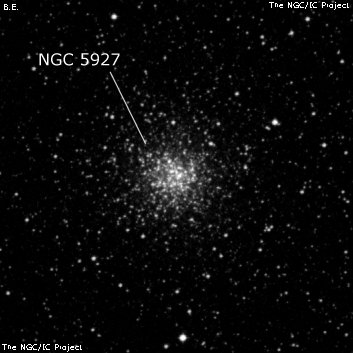
James Dunlop discovered NGC 5927 = D 389 = h3604 on 8 May 1826 and describing it (based on 8 observations) as "a very fine round pretty bright nebula, about 3' diameter, gradually brighter towards the centre, and well defined at the margin: this is resolvable. With a power of 260 it has a beautiful globular appearance. The stars are considerably scattered on the south side." John Herschel described it on 7 Jul 1834 as "globular, B, L, R, gbM, diam in RA = 16 seconds. Comes up to a bright blaze in middle. Resolved by left eye. Stars 17th mag." On a later sweep he called it "globular, pB, fine highly condensed, vgbM, 3' diameter, clearly resolved. I see all the stars (15th mag) well."
200/250mm - 8" (7/13/91 - Southern Baja): moderately bright, fairly small, 4' diameter, round, gradually increases to bright core, lively but no resolved. Fainter gc NGC 5946 is 70' E. Viewed at only 14° elevation from Baja.
400/500mm - 18" (7/4/05 - Magellan Observatory, Australia): at 128x, this fairly bright globular is fairly large, roundish, ~6' diameter. Broadly concentrated to a 3' core that brightens slightly to the center. Within the halo and scattered just outside the periphery of the ragged halo are two dozen faint stars, though it was difficult to clearly distinguish these outliers from the uniformly rich star field that surrounds the globular. At 228x, at least three dozen mag 14-15.5 stars are resolved and the core is very lively and granulated. I had the strong impression that it was on the verge of more extensive resolution. A mag 10 star lies 4.5' due south of center with a mag 11 star 3' NW. The halo extends to nearly the line connecting these two stars. NGC 5927 forms a pair with globular NGC 5946 just over a degree following within Norma.
Notes by Steve Gottlieb